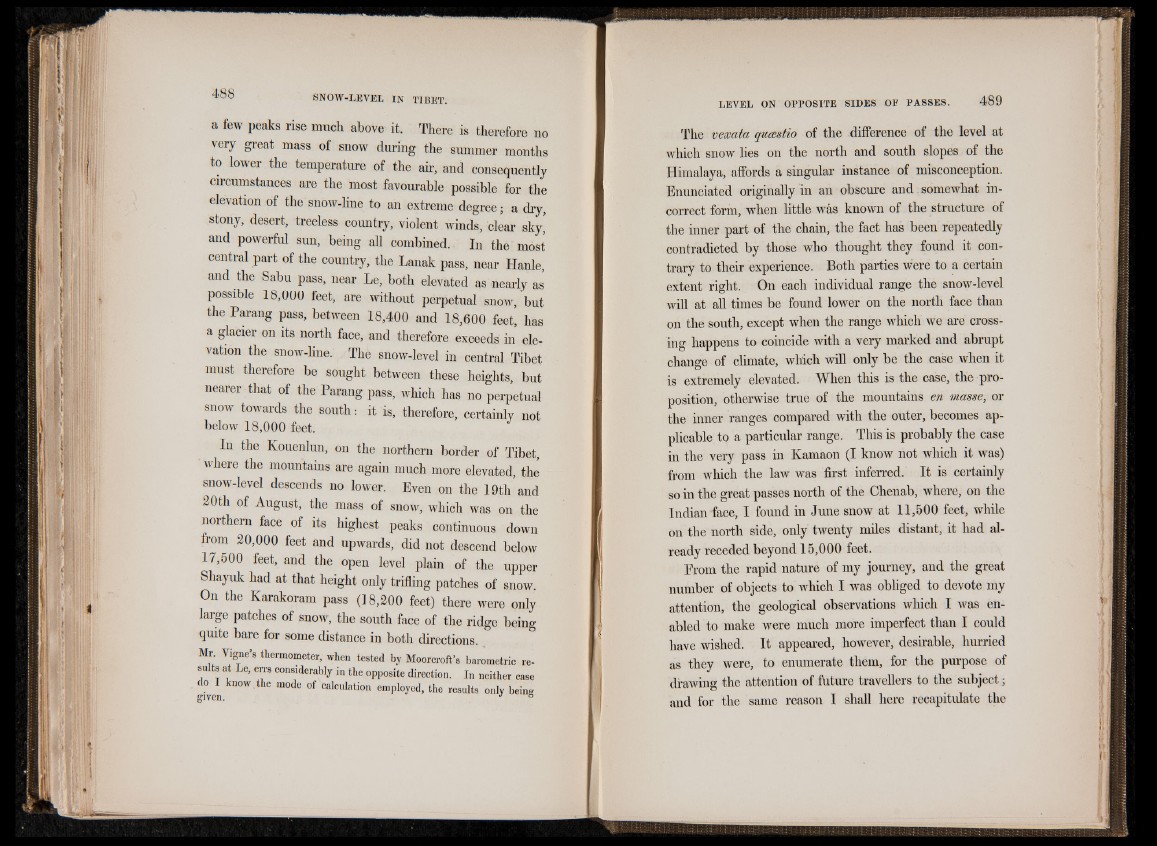
a few peaks rise much above it. There is therefore no
very great mass of snow during the summer months
to lower the temperature of the air, and consequently
circumstances are the most favourable possible for the
elevation of the snow-line to an extreme degree$ a dry,
stony, desert, treeless country, violent winds, clear sky
and powerful sun, being all combined. In the most
central part of the country, the Lanak pass, near Hanle,
and the Sabu pass, near Le, both elevated as nearly as
possible 18,000 feet, are without perpetual snow, but
the Parang pass, between 18,400 and 18,600 feet, has
a glacier on its north face, and therefore exceeds in elevation
the snow-line. The snow-level in central Tibet
must therefore be sought between these heights, but
nearer that of the Parang pass, which has no perpetual
snow towards the south: it is, therefore, certainly not
below 18,000 feet.
In the Kouenlun, on the northern border of Tibet,
where the mountains are again much more elevated, the
snow-level descends no lower. Even on the 19th’and
20 th of August, the mass of snow, which was on the
northern face of its highest peaks continuous down
from 20,000 feet and upwards, did not descend below
17,500 feet, and the open level plain of the upper
Shayuk had at that height only trifling patches of snow.
On the Karakoram pass (18,200 feet) there were only
large patches of snow, the south face of the ridge being
quite bare for some distance in both directions.
Mr Vigne’s thermometer, when tested by Moorcroft’s barometric results
at Le, errs considerably in the opposite direction. In neither case
to I know.the mode of calculation employed, the results only being
given. J °
The vexata qucestio of the difference of the level at
which snow lies on the north and south slopes of the
Himalaya, affords a singular instance of misconception.
Enunciated originally in an obscure and somewhat incorrect
form, when little was known of the structure of
the inner part of the chain, the fact has been repeatedly
contradicted by those who thought they found it contrary
to their experience. Both parties were to a certain
extent right. On each individual range the snow-level
will at all times be found lower on the north face than
on the south, except when the range which we are crossing
happens to coincide with a very marked and abrupt
change of climate, which will only be the case when it
is extremely elevated. When this is the case, the proposition,
otherwise true of the mountains en masse, or
the inner ranges compared with the outer, becomes applicable
to a particular range. This is probably the case
in the very pass in Kamaon (I know not which it was)
from which the law was first inferred. It is certainly
so in the great passes north of the Chenab, where, on the
Indian face, I found in June snow at 11,500 feet, while
on the north side, only twenty miles distant, it had already
receded beyond 15,000 feet.
Erom the rapid nature of my journey, and the great
number of objects to which I was obliged to devote my
attention, the geological observations which I was enabled
to make were much more imperfect than I could
have wished. It appeared, however, desirable, hurried
as they were, to enumerate them, for the purpose of
drawing the attention of future travellers to the subject j
and for the same reason I shall here recapitulate the